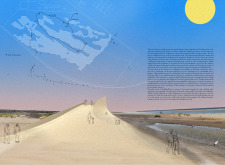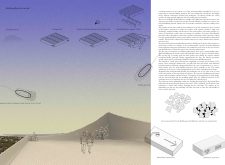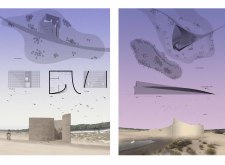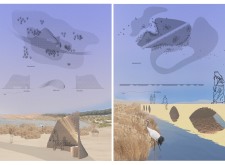5 key facts about this project
The Al Wathba Wetland Reserve is located within a distinctive desert landscape, where the design aims to bring together architecture and its natural surroundings. The space serves the public by offering a place for exploration and interaction. The overall design concept prioritizes a reduced ecological impact while making use of local resources. Central to the design is the use of sand, which influences the visual and structural components, allowing the architecture to connect meaningfully with the environment.
Central Dune Formation
At the heart of the design is a central dune formation that serves both as a landmark and a functional structure. This dune departs from conventional building forms by mimicking the look and feel of a natural sand dune. It changes shape based on the visitor's perspective, which encourages a closer engagement with the landscape. Moreover, the dune offers practical features such as providing shade and a place to view the surroundings, enriching the experience of being in a natural setting.
Shading Walls
Shading walls are strategically placed along the boardwalk to enhance visitor comfort. These walls protect against the sun's heat, allowing people to explore the outdoor space more comfortably throughout the day. By maximizing shade while blending into the environment, the walls contribute to a more inviting atmosphere, making the reserve a pleasant destination for all visitors.
Accessibility and Inclusion
The design carefully considers accessibility, ensuring that the space is inviting for people of all abilities. This attention to inclusivity reflects modern principles in architecture that prioritize equal access. The layout, along with thoughtful modifications, helps create an environment where everyone can engage with the natural beauty of the reserve. It emphasizes a commitment to welcoming diverse groups into outdoor spaces.
Innovative Material Use
One of the notable features involves using Bacillus pasteurii bacteria to create a strong biological cement that binds local sand into usable bricks. This method represents a departure from traditional construction practices by providing an environmentally friendly option. The resulting sand bricks are incorporated throughout the design, notably in the dune and shading walls, which reinforces the connection with the surrounding landscape.
Visitors will also find "infobricks" placed within the structures, providing information about the local ecosystem. These informative elements enhance visitors’ understanding and appreciation of the area. They also integrate naturally with the architecture, adding a layer of educational value to the experience. The combination of design elements reaffirms the spirit of exploration within the Al Wathba Wetland Reserve, as visitors navigate through both the architecture and the diverse natural setting.






















































